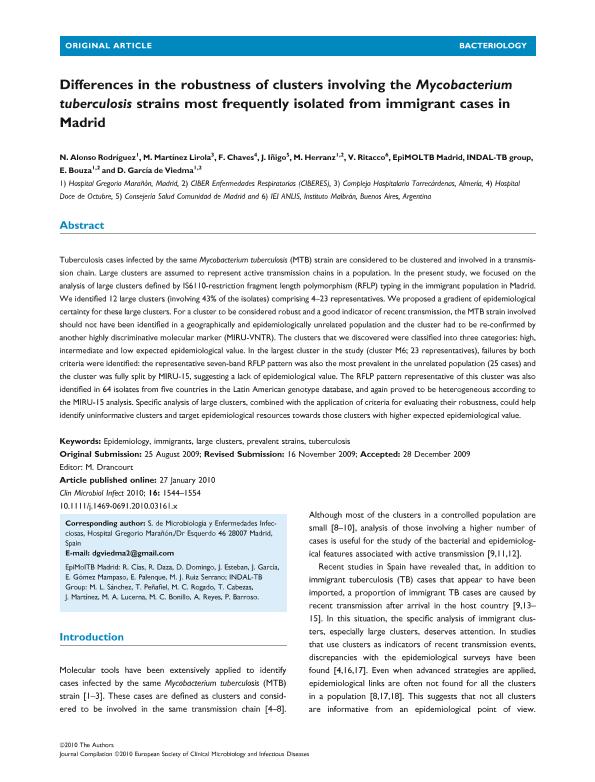Artículo
Differences in the robustness of clusters involving the Mycobacterium tuberculosis strains most frequently isolated from immigrant cases in Madrid
Alonso Rodríguez, N.; Martínez Lirola, M.; Chaves, F.; Iñigo, J.; Herranz, M.; Ritacco, Gloria Viviana ; Bouza, E.; García de Viedma, D.
; Bouza, E.; García de Viedma, D.
 ; Bouza, E.; García de Viedma, D.
; Bouza, E.; García de Viedma, D.
Fecha de publicación:
10/2010
Editorial:
Elsevier
Revista:
Clinical Microbiology And Infection
ISSN:
1198-743X
Idioma:
Inglés
Tipo de recurso:
Artículo publicado
Clasificación temática:
Resumen
Tuberculosis cases infected by the same Mycobacterium tuberculosis (MTB) strain are considered to be clustered and involved in a transmission chain. Large clusters are assumed to represent active transmission chains in a population. In the present study, we focused on the analysis of large clusters defined by IS6110-restriction fragment length polymorphism (RFLP) typing in the immigrant population in Madrid. We identified 12 large clusters (involving 43% of the isolates) comprising 4-23 representatives. We proposed a gradient of epidemiological certainty for these large clusters. For a cluster to be considered robust and a good indicator of recent transmission, the MTB strain involved should not have been identified in a geographically and epidemiologically unrelated population and the cluster had to be re-confirmed by another highly discriminative molecular marker (MIRU-VNTR). The clusters that we discovered were classified into three categories: high, intermediate and low expected epidemiological value. In the largest cluster in the study (cluster M6; 23 representatives), failures by both criteria were identified: the representative seven-band RFLP pattern was also the most prevalent in the unrelated population (25 cases) and the cluster was fully split by MIRU-15, suggesting a lack of epidemiological value. The RFLP pattern representative of this cluster was also identified in 64 isolates from five countries in the Latin American genotype database, and again proved to be heterogeneous according to the MIRU-15 analysis. Specific analysis of large clusters, combined with the application of criteria for evaluating their robustness, could help identify uninformative clusters and target epidemiological resources towards those clusters with higher expected epidemiological value.
Palabras clave:
EPIDEMIOLOGY
,
IMMIGRANTS
,
LARGE CLUSTERS
,
PREVALENT STRAINS
,
TUBERCULOSIS
Archivos asociados
Licencia
Identificadores
Colecciones
Articulos(SEDE CENTRAL)
Articulos de SEDE CENTRAL
Articulos de SEDE CENTRAL
Citación
Alonso Rodríguez, N.; Martínez Lirola, M.; Chaves, F.; Iñigo, J.; Herranz, M.; et al.; Differences in the robustness of clusters involving the Mycobacterium tuberculosis strains most frequently isolated from immigrant cases in Madrid; Elsevier; Clinical Microbiology And Infection; 16; 10; 10-2010; 1544-1554
Compartir
Altmétricas



